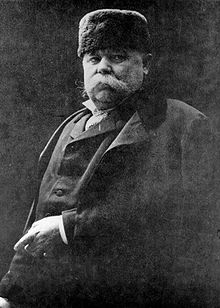art.wikisort.org - Artist
Đorđe Krstić also Djordje Krstić (Serbian Cyrillic: Ђорђе Крстић, pronounced [d͡ʑɔ̂ːrd͡ʑɛ kř̩ːstit͡ɕ]; 19 April 1851 – 30 October 1907) was a Serbian realist painter and academic.[1] He is often ranked alongside his contemporaries, Paja Jovanović and Uroš Predić.[2]
Đorđe Krstić Ђорђе Крстић | |
|---|---|
 | |
| Born | 19 April 1851 |
| Died | 30 October 1907 (aged 56) |
| Nationality | Serbian |
| Education | Academy of Fine Arts, Munich |
| Known for | Painting |
Notable work | Anatom (1880) Pod Jabukom (1883) |
| Movement | Realism |
Biography
Krstić finished his education in Munich, Germany,[3] where he began his early works under the influence of German realism up until 1883. Some significant works of this early period include The Drowning Maiden, Anatomist, and The Gospel Writer.[4] In Serbia, Krstić moved his style of painting from a realist tone to a more idyllic one, with paintings such as Kosovo Field Landscape, From the Surroundings of Čačak, From Leskovac, Studenica, and Žiča. In his later years, Krstić began painting a number of iconostases in Čurug and Niš, working with architect Mihailo Valtrović, of which include the controversial Death of Prince Lazar.[5]
Krstić painted more than 50 works based on Serbian folk art and traditional clothing.[6]
Legacy
He is included in The 100 most prominent Serbs list.
Gallery
- Drowned, 1879
- Studenica monastery, 1881-1883
- Na izvoru, 1882
- Saint Sava blessing young Serbs, 1891
- Babakai, 1892
- Milan I of Serbia
See also
- List of painters from Serbia
- Serbian art
References
- "Arte - Đorđe Krstić - Biografija". www.arte.rs. Retrieved 17 December 2019.
- "19. vek". Nedeljnik Vreme. Retrieved 17 December 2019.
- "Đorđe KRSTIĆ; slikar". www.srbijanac.rs. Retrieved 17 December 2019.
- "Dve slike Đorđa Krstića sa stalne postavke Narodnog muzeja: "Utopljenica" i "Pad Stalaća"". Retrieved 17 December 2019.
- Valtrovic, Mihailo (1889). "Pogled na staru srpsku crkvenu arhitekturu".
- Београду, Етнографски музеј у; Влаховић, Митар С.; Pap, Károly Szathmári; Радовић, Босиљка (1958). Народне ношње XIX века у Београду (in Serbian). Издање Етнографског Музеја.
| Wikimedia Commons has media related to Đorđe Krstić. |
- (in Serbian) Rastko Directory
На других языках
- [en] Đorđe Krstić
[fr] Đorđe Krstić
Đorđe Krstić (en serbe cyrillique : Ђорђе Крстић ; né le 19 avril 1851 à Stara Kanjiža - mort le 30 octobre 1907 à Belgrade) était un peintre réaliste serbe.[ru] Крстич, Джордже
Джордже Крстич (серб. Ђорђе Крстић; 19 апреля 1851, Канижа, Княжество Сербия — 30 октября 1907, Белград, Королевство Сербия) — сербский художник-реалист, педагог, академик.Другой контент может иметь иную лицензию. Перед использованием материалов сайта WikiSort.org внимательно изучите правила лицензирования конкретных элементов наполнения сайта.
WikiSort.org - проект по пересортировке и дополнению контента Википедии





